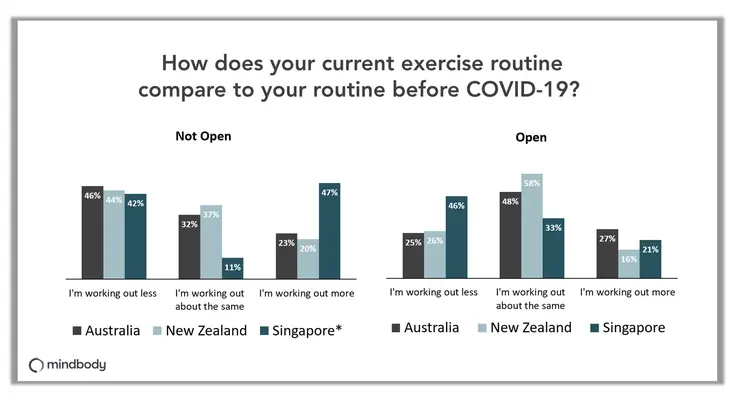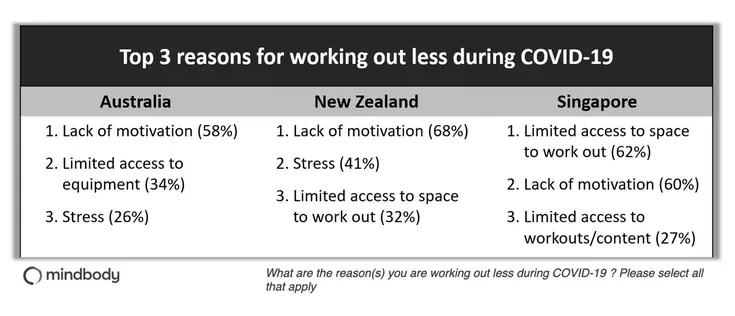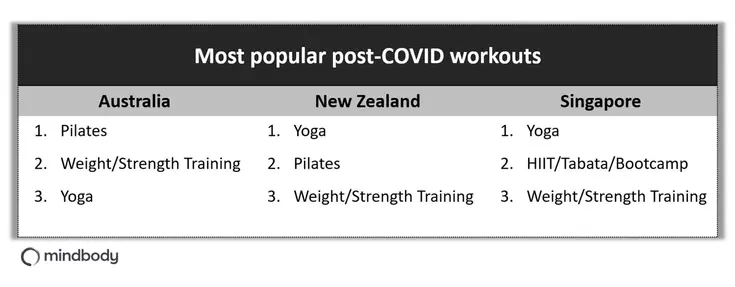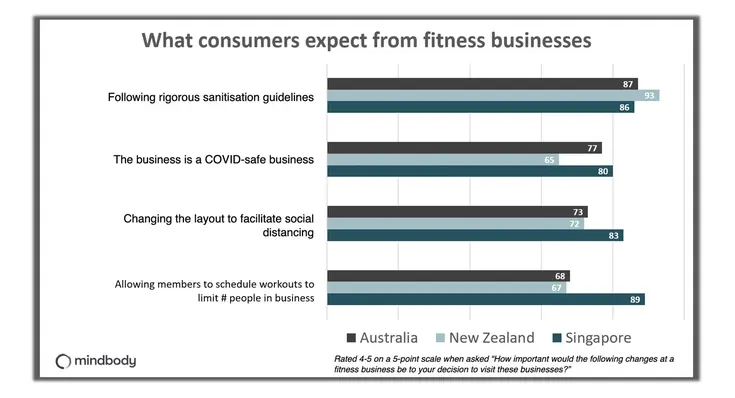
How COVID-19 Has Changed Fitness in APAC
Last updated: August 4, 2025
Since the global pandemic began, the world has been forced to adapt. In the fitness industry, this is especially true. Fitness studios have been through the ups and downs of having to close, reopen, and for some, close again. Consumer routines have been disrupted, too. Instead of in-studio classes, working out from home and interacting with their favourite studios on-screen have become the norm.
We surveyed Mindbody consumers in Australia, New Zealand, and Singapore to find out how their fitness routines have changed and how they'll continue to evolve in the months to come. Here's what we found.
Closures had an impact on fitness routines
Although stay at home orders caused many consumers to work out less (over 40% of consumers in all three APAC markets said they're working out less than they were pre-COVID), the majority have returned to their pre-pandemic fitness routines once communities reopened.
As fitness studios reopen, most consumers are working out about the same pre-COVID. In some markets, like Australia, 3/4 of consumers report working out about the same or more. In terms of workout frequency, Australians move often—75% of Australian consumers work out 3-4 times per week, or more.
Still, a percentage of consumers haven't returned to their regular fitness routines. (25% in AU, 26% in NZ, and 46% in SG).
Business tip: Encourage clients back into the studio—or back on screen—with a targeted, welcome back campaign. This might include a challenge, a "back at it" virtual or in-person workshop series, or class offerings specifically for those just starting or returning to a fitness regimen.

Lack of motivation is the top reason for working out less during COVID-19
Consumers overwhelmingly indicate a lack of motivation as the primary reason for working out less during COVID-19. This is followed by limited access to equipment, stress, and limited access to space to work out—especially in Singapore. The steep decline in intrinsic motivation to stay physically active and healthy indicates that the pandemic has had an impact on the mental and emotional state of consumers.
Business tip: Get creative to help consumers get back into a routine and find a renewed sense of motivation at your studio or gym. Start an attendance challenge, host themed classes, or pick up the phone to simply call or text members. Here are 34 ways to keep fitness members motivated.

Consumers prefer in-person workouts
Across the regions, consumers report that they usually or almost always prefer in-person workouts to their live stream counterparts (71% for AU, for 80% NZ, and 73% for SG). A sense of community, more motivation/accountability, and feedback from instructors are listed as the top three reasons why. This is good news for fitness businesses that, upon reopening, will have the opportunity to leverage the power of their instructors and communities, in-person.
Business tip: Consumers may prefer to be in person but virtual offerings remain a powerful way to engage both current and prospective customers. Make virtual classes feel more like the studio by incorporating elements of in-person fitness—community, accountability, and instructor feedback.
But...virtual workouts are here to stay
While consumers do prefer in-person classes, the large majority are still planning to keep virtual workouts as part of their ongoing fitness routine. 60% of consumers in Australia/New Zealand and 77% in Singapore say they'll incorporate virtual workouts moving forward.
While the majority feel they'll participate in virtual classes once per week (51% in AU, 47% in NZ, and 55% in SG) more than one third of consumers across all regions said they would likely use virtual 2-3 times/week (37% in AU, 44% in NZ, and 35% in SG). Around 10% said they'd do 4 or more virtual workouts per week.
When we asked consumers what type of virtual workout they preferred, it was fairly evenly split between live streamed workouts and pre-recorded, or video on demand, workouts, with Australians being the only ones to slightly prefer live streamed workouts over pre-recorded ones.
For Australians who indicated they preferred virtual workouts, convenience (no commute, flexible schedule, ease of use) was the driving factor, along with less "gymtimidation," with 38% of Australians saying "no judgement" was why they preferred virtual workouts compared to in-person.
Business tip: Incorporate virtual offerings into your business plan, long-term. This kind of hybrid fitness business (offering both in-person and virtual classes) will serve studios and their clients during the pandemic—and beyond.
The top types of fitness classes have changed for some countries
Not only has COVID-19 had an impact on frequency of workouts, it's impacted the types of fitness classes consumers are choosing, too. Before the pandemic, yoga was the most popular workout across Australia, New Zealand, and Singapore.
These days, Australians are looking first to Pilates then to yoga and weight/strength training to get their sweat on. New Zealanders remain dedicated to yoga and Pilates. Similarly, Singaporeans remain constant with yoga and HIIT/Tabata/Bootcamp.

Now that consumers are returning to their favorite studios and gyms, they may be opting to use more equipment in their routines (e.g., the reformer for Pilates and dumbbells/barbells/machines for weight/strength training) that weren't as readily available at home.
Business tip: Understand the evolving preferences of your customers and consider adding new types of classes or workshops (virtual or in-person) to your studio or gym's schedule. Survey your clients to see what they're interested in trying. Then, test it out. For example, a yoga studio might add a Pilates class once a week. A HIIT studio might offer a strength training series.
Sanitisation is key
As consumers make the return to fitness studios and gyms, "following rigorous sanitisation guidelines" is by far the most important change they're looking for across all regions. This is closely followed by "the business is a COVID safe business" and "changing the physical layout to facilitate social distance."
Business tip: Be intentional with sanitisation and social distancing protocols—and the way in which you communicate them. Reassure clients by posting signage in your facility and outlining processes on your website and social media. For more on cleaning your fitness business in the wake of COVID-19, check out this blog post.

Consumers are most comfortable returning to boutique fitness studios
Consumers across all reopened regions indicated they prefer boutique fitness studios (such as studios for yoga, Pilates, spin, HIIT, etc.) over larger gyms and health clubs. This is likely due to a more intimate and controlled experience for customers at boutique facilities. Members are also more likely to be familiar with one another, creating an added element of trust.
Business tip: Larger health clubs should consider ways to create a more intimate experience for members, including appointment-only visits and/or classes with strict capacity limits.
Spending habits have changed
In April, during peak COVID-19 restrictions in Australia, spend on fitness services dropped drastically by 39%. However, in welcomed news for the fitness industry, the average spend in July almost rebounded to pre-COVID levels. Of this expenditure, more than half of Aussies' fitness budgets were dedicated to virtual fitness, whilst the rest went to existing fitness memberships.
The majority of Australians anticipate their spending to remain the same as it was before restrictions (67%) with a minority (16%) expecting to spend more or a lot more on exercise after restrictions are completely lifted. Increased frequency of classes (57%), prioritising fitness (39%) and supporting local businesses (37%) are the top reasons Aussies expect to spend more.
Business tip: Continue to promote the value of your offerings. Remind customers you're not simply providing workouts, you're improving their physical and mental health, providing a sense of community, and so much more.
The coronavirus pandemic has presented an opportunity for both fitness facilities and consumers to rethink the industry as a whole. Across APAC, fitness businesses will need to consider the shifting needs of consumers—and respond accordingly. Those that embrace and evolve with these changes will emerge stronger on the other side of this.
Mindbody. "APAC Consumer Survey - COVID-19 and the New Normal." 2020.



